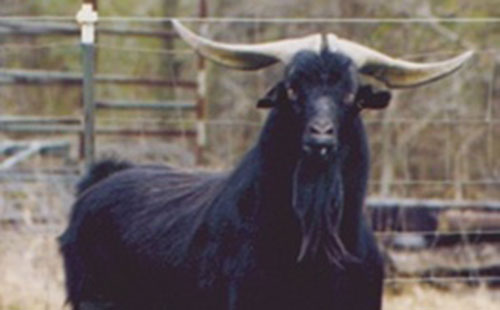At Pleasant Ridge Goats we are happy to be participating in our first Buck Test. Phillip Wilborn and Kraig Stemme help us transport our goats to Eastern Oklahoma University. It turns out that we are about the same distance from the Maryland and Eastern Oklahoma buck tests, but my schedule would not allow us to transport to either tests. We have been working to develop a herd that is based on pasture performance so this is an important tool for us to check our progress. After talking to Dr Kraig Stemme, we decided to go all in for testing. We sent the maximum number we were allowed, four, and we decided to send our best. Of the four we sent, two of them were out of our embryo flush- PRG Blue’s Bootlegger and PRG’s Blue’s Midnight Sky are both by SKY Blue’s Son. The other two (F24 and F27) were top performers out of GHK Mulan and GHK Yoshi. They are triplet sisters out of Little Blackie and Loverboy. Their sire is GHK Mufasa (Iron Hose X Tasman Toia). These four were among the highest weaning bucks and each continued to gain well for the 30 days after weaning (especially F27). We are really excited to hear the the updates coming out of Oklahoma. Laura and I are planning to keep one of the Blue’s Son bucks as herd sire, and our two best candidates are Bootlegger and Midnight Sky. Hopefully the test will give us an idea of which would be the best for our herd. We will keep everyone posted!
Rich
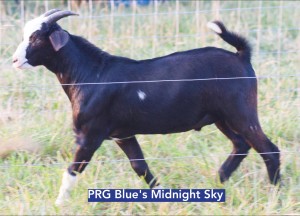
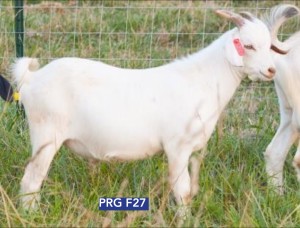
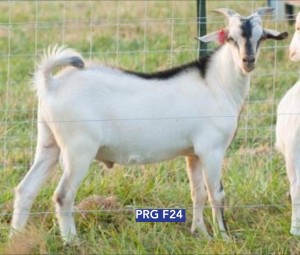
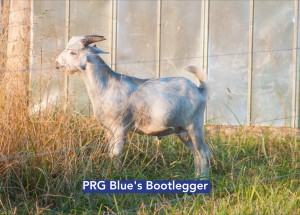

This has been a super busy week out at the farm. Like I posted earlier, we had been working overtime to get the farm ready for a special event. We were honored to host David and Brittany Carwell, of B&D Genetics for a buck collection. For those who are unfamiliar with this, let me explain. Livestock breeders typically spend top dollar to purchase the best bull, stud, or buck (male goat, or billy goat) they can afford. Often, this is quite an investment. Because of the impact one top level male can have over the genetics of your herd, it stands to reason that he should be your best animal. In order to protect that investment, it is possible to collect semen on these animals and freeze it in liquid nitrogen. It’s kind of an insurance policy, should anything happen to that animal that keeps him from breeding. It also allows other breeders to use his semen to breed to their females on other farms without transporting the buck to their farm (a biosecurity risk and hassle). Believe it or not it is possible to buy and sell semen from bulls or bucks or horses, or other species. This process also allows breeders to preserve the genetics of exceptional animals for future use.
With all of this in mind, we invited David and Brittany to come to our farm to collect our bucks. To make it worth their time, we also invited other breeders to participate. We were pleased with the response we received. We were very happy to host Dick and Sally Rutherford of Bear Creek Kikos in Illinois, Phillip Willborn of Just Kiddin’ Caprines in Alabama, Gary and Lydia Richardson of Overlook Farm Kikos from Georgia, Robert Shonerd of Kennesaw Mountain Kikos from Georgia, and Josh Headden of Headden’s Kikos from South Carolina. Between us we brought twelve bucks for collection.
It turns out collection twelve bucks is a lot of work. Of course the work started for us about a month ago. We had several discussions with David and Brittany to get an idea of what they would need to make this day successful. We wanted a smooth day- for them to have a good experience since they were so kind to travel from Arkansas! We took their suggestions and modified our facilities to make this work.
The process of collection is would seem weird and maybe gross to many. So, read on at your own risk. But the technique David uses is certainly humane. He gets in the pen with the buck and a teaser doe. A teaser doe is a mature female that has been hormonally programmed to be in heat the day of the collection. When the buck goes to mount the doe, David leaps in there and catches his penis in a sleeve-like device (technically an artificial vagina) that collects the ejaculate. David then hurries off to the trailer to preserve the specimen. You’ll get no more info from me on that process (except to say that after peppering David and Brittany with questions all day, they really know their business).
The Kiko breed is more challenging than other goat breeds to collect, according to David and Brittany. Because Kikos spend so much time on the pasture being goats, they typically have less human contact. Even though a calm disposition can be bred for, Kiko breeders are focusing on other traits like average daily weight gain, parasite resistance, superior mothering, etc. When people are around Kiko bucks can get nervous and reluctant to breed, making them hard to collect. This is why we spent a lot of time and energy remodeling our goat barn. We added walls to the old horse stalls, dropping them from 12′ x 12′ to 6′ X12′ and lower the wall height. We thought the drop in height would improve air flow and also allow the bucks to see as well as hear and smell the teaser does. The does themselves we put in the center of the barn and enclosed them in a six foot high kennel made of welded wire. Our bucks and does were put in the ban on Monday allowing them two days of close contact. The other bucks were moved into the barns soon as possible. Judging by the reaction of the animals, the layout was quite a success. They had each other quite riled up by collection time. There is one modification I am going to make before next time. I’m going to add another foot of height to the stalls using goat panel. We did have one buck who was motivated and athletic enough to jump the gate and try to dance too closely with the ladies (luckily no unauthorized breeding took place).
From what David and Brittany told us afterwards, it seemed like our layout helped them a lot. Like I said earlier, they really know what they are doing, but Kikos can be dang hard to collect. After being in there with the does, though, several of them took about 10 seconds to collect! One of them was mounting as soon as the female got in there, before David even got in the stall. By noon (I think), we had completed collecting all twelve bucks successfully.
Of course David and Brittany still had plenty of work.
We were really happy with the results of the collection. B&D Genetics gets my unreserved recommendation! They are very knowledgeable, personable and professional. They have their own mobile lab, so they really don’t need too much from the host breeders (except some attention to the layout). All they need from us was a water source. Electricity is nice, too.
I also wasn’t to thank each of the breeders who participated in the collection. Without them, we would not have been able to make it worth the trip for David and Brittany. And, to anyone who is relatively close and would have liked to participate, we are pleased to announce that B&D Genetics has agreed to return to our farm next year for another collection! It should be around the same time next year, but we don’t have dates, yet. If you’re interested, contact B&D Genetics or us on Facebook at Pleasant Ridge Goats, or on our website at www.pleasantridgegoats.com.
Rich Davis
Pleasant Ridge Goats
Carrollton, GA
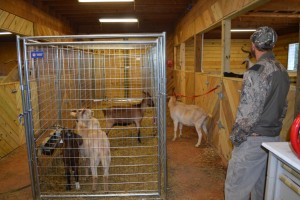
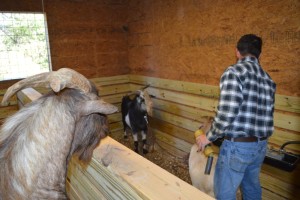
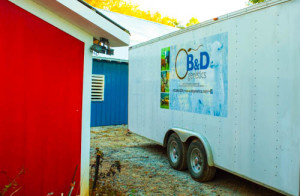
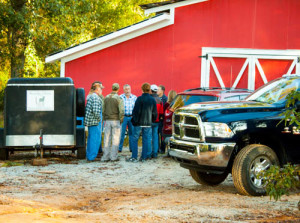
We have been really working overtime to get one of our barns (the blue one) on the farm refurbished. Man! it’s been a lot of work! I did break down and hire Exterior Armor for the siding and new roofing. And a good friend, Kevin Knox, got the electrical work squared away. The painting was done by Jose Ibarra. All the carpentry, wood work and plumbing was done by yours truly. Sometimes it does take a village. The reason we put so much into this was that we were going to be hosting B&D Genetics for a buck collection (more about that in another post). Anyway, this is the biggest project I’ve taken on so far and I’m so excited about the end result. A special thanks to those who put so much into this project. And especially to my wife who allowed her husband enough time away from home to get this monster project done!
-Rich
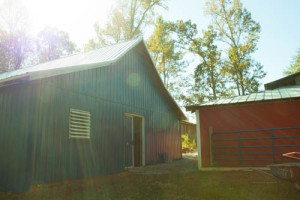
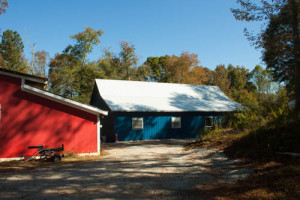
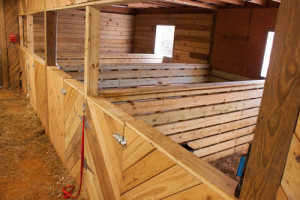
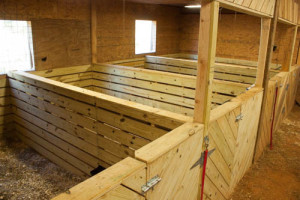
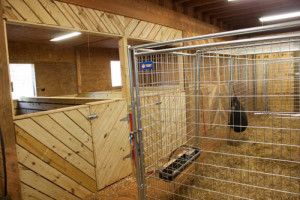
Today is a big day for our breeding program. Last Froday (9/11/2015), we did the artificial insemination (AI) portion of our embryo flush. I am partnering with several others in this flush. Lee Patrick of Ragin River Kikos is the lead breeder for this flush. Between the does he flushed and did AI on, he used Blue’s Son, Heslington Sesame, JFK Noble, 14/89, TAY Onyx and Sports Kat. So quite a few rare genetic lines there. Very excited for him.
For our program, we are trying to build a top tier foundation doe herd. One of the Kiko qualities that we value highly are the maternal characteristics, so we are making an effort to flush those lines most likely to produce durable, healthy, great mothers. Gary Richardson and I are partnering on a flush with JFK Noble over SDR Lara Bear (Newman Bear x Lark Bear). Erin London and I are also partnering on a flush. Our flush is Blue’s Son on our own GHK Venus (Iron Horse x Tasman Toia). After searching and negotiating all summer, I was able to get some Sunboy 117 (Loverboy) semen. We are fortunate to have three NZ Loverboy daughters in our herd, and this is my favorite genetics line for does. After a lot of consideration, we selected GHK Sarabi to use with the Loverboy semen. She is an Iron Horse x Lightin’s Lady doe. Her dam is by Sunboy Waco 139 (Lightin) and out of a Generator daughter. This gives us a great combination of Moneymaker, Iron Horse and Generator. We are hoping this gives a winning combination. Lastly, we are flushing AVG Jodi (Ozark Rathe x AVG Miss Spots- a LEN 8 doe). Ozark Rathe is currently at the Nebraska University farm and we have been told he produces the most parasite resistant offspring in their program. Jodi is a thick blue roan doe who is a heavy milker. We are excited to see the product of this cross. We should see tough, hardy goats that grow out well and have great maternal characteristics.
Today is the embryo flush portion of the process. We will find out today how many embryos each produced and will be implanting the embryos on our recipients. Not every embryo carries through all the way to kidding, but this gives us an idea of how many kids we can hope for. We haven’t flushed any of these does before, so how well they program and how many eggs the will produce is an unknown.
Well, I will post later when we know how today goes.
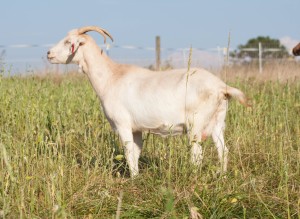
GHK Sarabi
Before we purchased our farm in 2012, the previous owners had kept horses in the property. So, while we were happy to have two barns, they are set up for horses. I have been aching to get things set up to be more goat-oriented. This summer we have started, to overhaul one of the barns. My friend, Kevin Knox, and his sons have been redoing the electrical wiring, so that its up to code (don’t need to update the barn if it’s just going to burn down!). We are redoing the stalls for when we need to keep a closer eye on certain goats. We are also opening the stalls so that there is more ventilation. It’s been a lot of work so far, but Jacob, my oldest son, has been right there helping and my wife has been been very supportive. Plus I enjoy carpentry work, it’s a good break from my daily job.

It’s been a whirlwind around here the last few weeks. The SEKGA sale this last weekend was fantastic. The stable of goats offered, top to bottom, was probably the best caliber I’ve seen at a sale. Before the auction I was telling my wife that I thought there were a huge number of $1,000+ does. A friend saw me looking and asked me if I had a few picked out I told him that picking out a few was tough, but I had picked out about 15 that I wanted, just couldn’t narrow it down.
As I said, the quality was high, and the buyers’ interest was, too. The average price for the 100% NZ does was over $1,400. I haven’t seen an average that high before. As a side note, the NKR sale two weeks ago also brought very high prices. We were only buying this week but we’re able to get two high quality does that will be ready for breeding this fall. Also I noticed that the high selling doe this year was out of a daughter of Blue’s Son, the buck we plan to use in this year’s fall flush. We bought Lady Raven from Brent Ballinger, look at her pedigree going back. Her twin sister is already on our farm and has done a great job, so we feel like we know what we are getting here. The other we bought was a daughter of Spring’s Merlin brought by the Seleskas. Since their family does such a fantastic job running the sale, I should bring home their best goat. Gratitude, you know. Merlin puts tremendous length and depth of body on his does. You’ll notice that her dam goes back to Sunboy Rotan 150, a Betula Hills Moneymaker son. Spring’s Foxy Girl has excellent conformation and has very nice coloring, too. One thing that was interesting to us is that on several occasions we were bidding against a phone bidder. Afterwards I asked who I was bidding against and I found out it was one of the top breeders in the industry. So that made me feel like we bidding on the right goats!
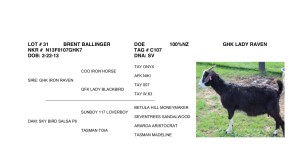
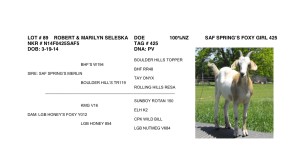
The high prices that we are seeing this summer make me think that there is an upswing in the Kiko breeding stock market right now. We feel very fortunate to have built most of our foundation herd. If you are thinking about getting into Kiko goats, know that the word is getting out and demand is going up. It’s a great time to be getting into goats. Remember that the U.S. still imports over 50% on the goat meat consumed here in the US. There is great room for expansion. The buyers would rather eat fresh, domestic goat over frozen, imported meat, but we aren’t producing enough. We need more meat goats!
We had a great time at the NKR Spotlight sale last weekend at Cookeville, TN. It was a great sale with great people. As usual, the lectures were very good and the speakers were among the foremost authorities in the field, including Dr Ann Peschel. For me, much of the learning takes place outside of the lecture hall, talking to producers. With raising goats, much of the “what do you do when this happens” knowledge can’t come from a book, because the books haven’t been written yet. The producers with years of experience that come to these sales are the best source of information.
This sale we got to have dinner with many of those producers, including Dr. Ann Peschel and hear about the stories about the original importation of the Kikos. It was a very entertaining discussion for all there, except maybe my children who mostly wanted to go swimming again.
The sale itself was a great success. We had three consignments, yearling does. We were very pleased to see them average over $1,000 each. We brought home 4 top shelf does, two of which had kids. The first we bought was an all black purebred with a large black buckling on her side (there had been a daughter that was lost to exposure). This does is a 3/4 sister to one of our most hardy does, Stitch. After I handled the buckling I’m even more sure that he’s a herd sire candidate.
The next does we bought was definitely the gem of the sale. She is a thick creamy colored doe with spots that is bred to Terminator XXX, one of the hardiest and parasite resistant lines in the breed. She herself is a full daughter to Sunboy 117, Loverboy. She is a product of AI (that’s artificial insemination-not artificial intelligence), bringing back to us a genetic line that is generally held to be the strongest maternals in the breed. Loverboy is also know to put thick, meaty kids in the ground and to have above average parasite resistance. Having her in our fold gives us three Loverboy does (along with Mulan and Yoshi) as well as a buck, Loverboy’s Lane Bear. We will be able to continue to deliver to our customers the great maternal instincts they need from the Kiko breed. Loverboy’s Hanky Panky, as she is called, also has a dam from great genetic lines. Her mother is a granddaughter of TAY Onyx, ECR Hanky Panky, SKY Sports Kat, and ECR Gloria.
The next doe we went after is a 3/4 sibling to Outlaw Honey, whom we thought was the outstanding doe at last year’s Spotlight Sale. She is a yearling doe that weaned off at 49# as a triplet. High hopes for her
The fourth doe we got had twins on her, one of whom is spotted. That doesn’t have any commercial, but sure got my kids excited. She is out of LEN 8, another buck know for excellent maternals. She is not the biggest doe, but the best metric for a doe is doe efficiency. That is the weight of kids weaned divided by the doe’s weight at weaning. She’s got two great kids at her side, demonstrating that she’s plenty big enough to raise nicely sized kids and do it more efficiently!
Thanks to all the breeders who brought their best! That’s what makes for a great sale.
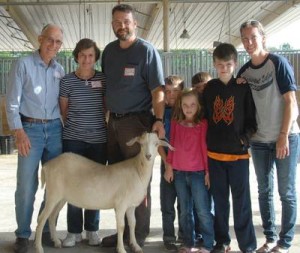
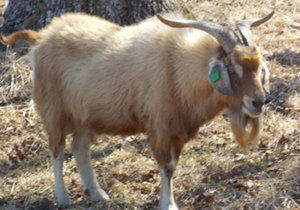
Yesterday, our herd took a big step forward. We brought home Ozark Apache from Arcadia Valley Farms. This buck has put quite a few kids in the premium Kiko goat sales and we are proud to have him join our farm. When we looked over our kids for the year 2014, we noticed that both the best doeling and the best buckling had had the same sire- Apache.
I was quite pleased, and surprised, to find out that he was available for sale. We scooped him right up and we can’t wait to get some more of his kids on the ground. Unfortunately, we will have to wait, our does are all bred now. It will be a long wait until 2016, but we are confident that the wait will be worth it.
On our farm, we felt very pleased to have one of the last Iron Horse and Tasman Toia sons (Mufasa) for our main herd sire. This year we had the chance to add a son from Heslington Sesame and Rosemary Bear. He was the product of last year’s embryo flush by Dick Rutherford and Chris Patrick. He weighed out at 57.8 pounds at weaning. In addition to rapid growth, rare genetics, he also has fantastic color (even though we aren’t supposed to care about this, it doesn’t hurt that he is easy on the eyes).
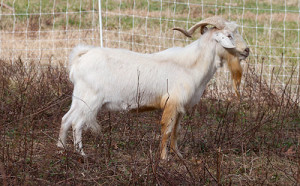
All this to say that we were quite happy with our young herd sires and had our breeding plan for this year all worked out. Then, out of the blue we got a call from a Kiko breeder that we had never met that got us really excited. Ms Ann Rogers got our name from another breeder and heard that we appreciated to older genetic lines. She had a Sunboy 117 (Loverboy) son that she was looking to place. Apparently he had lived up to his sire’s reputation (he was known to produce does that are excellent mothers). She had so many of his daughters that she had kept that she didn’t have many does left to breed him to that weren’t his daughters. So we were able to add a Loverboy son to our herd! We are certainly happy to have him on our farm. We even had a few does left that we were able to breed to him this year.
This year PRG had the chance to participate in embryo with some of the best Kiko breeders in the US. Dick Rutherford (Bear Creek Kikos), Chris Patrick (Ragin’ River Kikos) and Brent Ballinger (Mill Creek Farm) all participated, and we were invited to join them! We brought one of our Loverboy does (Mulan) along with our recipients from Richard Howard in Powder Springs GA.
For those of you new to breeding livestock, let me explain a little about this technique. First, you choose which of your does from which you would like most to have more kids. This might be to increase certain traits or bloodlines in you herd, or perhaps for more valuable breeding stock. Next you select does as recipients which have strong mothering traits (probably want to stick with at least 50% kikos here), and are healthy stock that have kidded at least once. Your animals are then taken to a farm where these procedures are performed (for us, we went to Erin Garnick’s Farm in Crittenden, Ky). It takes several weeks for them to get acclimated before any procedures are done. Then the donor doe and recipients are prepared with hormones, which synchronizes their estrus cycles. If this doesn’t happen, you’re done before you get started. Your donor does is then programmed to supraovulate (release multiple eggs in one cycle) using follicle-stimulating hormone. About one week later, the embryos are flushed out on the donor’s uterus and implanted in the recipient does.
Interestingly, Mulan is herself a product of artificial insemination. She’s a Loverboy (Sunboy 117) daughter out of Lady Blackbird (from Goat Hill Kikos). After much thought and a lot of advice from our partners, we selected TAY Onyx semen to flush to our Loverboy daughter. This cross is known to produce great kids and so we went with a proven winner. Our donor produced 16 enbryos which were implanted on eight recipients. So far we have five does that are confirmed pregnant from the flush. We had hoped for a higher rate of pregnancy, but then, this is our first flush. We’re looking for a kidding date around February 13, 2015. Happy Valentine’s Day to us! And maybe to you, too, if you’d like to add one of these kids to your herd. Keep us in mind and come take a peek next spring!
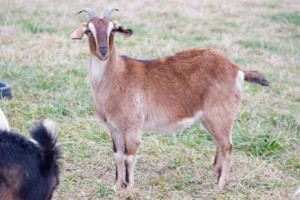 Also, I got a surprise during this flush. I was looking forward to helping Dr. Peter Lynch in anyway I could, but I didn’t realize how much work he had for me. I got to handle the anesthesia for all the donors and recipients. This felt familiar, since I do anesthesia everyday, but typically on humans. It really tickled me to get to take care of all those goats. You can imagine how much fun my colleagues had when I told them I had been intubating goats!
Also, I got a surprise during this flush. I was looking forward to helping Dr. Peter Lynch in anyway I could, but I didn’t realize how much work he had for me. I got to handle the anesthesia for all the donors and recipients. This felt familiar, since I do anesthesia everyday, but typically on humans. It really tickled me to get to take care of all those goats. You can imagine how much fun my colleagues had when I told them I had been intubating goats!
























